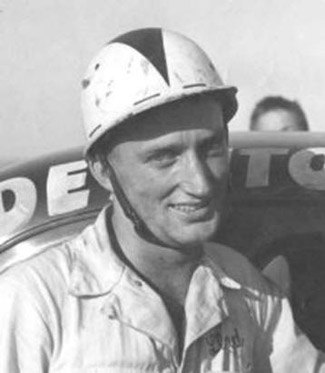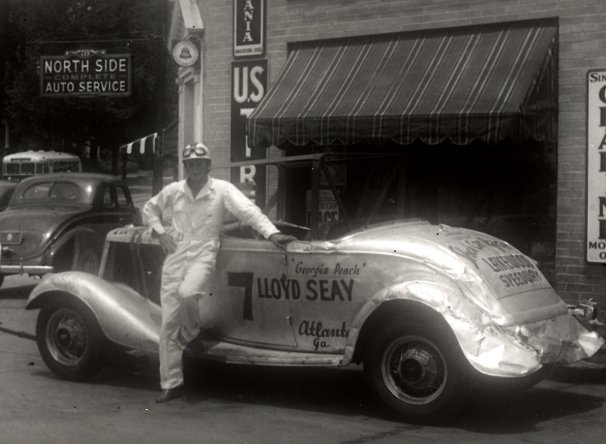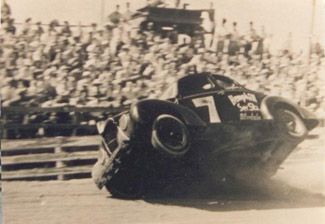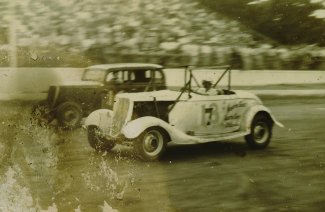
Lloyd Seay is considered by many to be the greatest natural talent in a stock car. Photo courtesy GRHOF
By Cody Dinsmore-Guest Contributor
Posted in Columns 1/13/11
The short but daring career of Lloyd Seay began somewhere around the summer of 1934 in the hills of Dawsonville, GA.
When he was as young as 13 years old, he was driving some sort of jalopy to haul a small load of Dawsonville’s finest moonshine out of the woods and down to Atlanta.
He most likely at the time worked for the legendary Raymond Parks, his older and successful cousin.
Many lawmen that covered “the old bootlegger’s trail” also known as GA Highway 9 were quoted as saying Seay was the best automobile driver they’d seen. When running the precious white liquid to Atlanta, you had to be careful. If any bottles or jars broke, you lost money.
But that certainly didn’t apply to Lloyd Seay. He could ease in and out of the winding mountain roads and make his way down to the re-built city of Atlanta. He could easily top 100mph while driving with his palms at the bottom of the steering wheel facing up. That allowed him to make a complete turning motion at once if he ever needed to make a 180 degree bootlegger’s turn.
However, “Lightning” Lloyd, also known as Parker to his friends, was known not only for his skills off the track, but also on the track too. In the fall of 1938, businessman and promoter Frank Christian was traveling to his home in nearby Dahlonega when he glanced off to the side of the road in an abandoned corn field near the river.
There he spotted some of the fastest street cars racing in circles with a small group of locals who came to see the excitement after church. When he approached one of the drivers, they told him that they were trying to see who had the fastest moonshine runner.
That’s when it all clicked for Christian. He thought that if these people were coming out for free to see these guys run, then they surely would pay to see them on a professional track.
He was right. On Armistice Day of 1938, the first known and organized stock car race was held in the state of Georgia. Frank Christian decided he would rent the Lakewood Fairground Track in the heart of Atlanta. But auto racing there wasn’t his idea. As early as 1916, the first auto race was held there with Indy type cars racing the clay mile. Pryor to that, it was used for Horse Racing.

Lloyd Seay poses in front of Raymond Parks’ Hemphill Service Station. He went on to win at Lakewood in 1938. Photo courtesy Eddie Samples
Hundreds of people gathered to the Lakewood Fairgrounds to watch what some would say is one of the most historic moments in Georgia Racing History. The race was just a small, 50-lap event with Lloyd Seay driving his 1934 Ford roadster with a broken arm to a win against the likes of his cousin Roy Hall, Bill France, Jap Brogdan, and Bob Flock.
But he never would have gotten to get that trophy, without one Mr. Raymond Parks. Parks was one of his Dawsonville cousins. Seay worked for Parks starting around 1934 or 1935 in the moonshine business along with their cousin, Roy Hall. When Seay got word that an organized stock car race for the local moonshiners and hot-rodders, he pleaded and begged Parks’ to field him a modified moonshine car.
So Parks talked to his friend, Red Vogt, who also built Seay and Hall’s moonshining cars, about building a monster of a racecar for the upcoming Lakewood event. Parks’ figured if he lost that race, then he wouldn’t have to deal with racecars any more. But he was wrong.
Since most of the 38’ season was over with, the three cousins waited until the start of the 1939 season to continue their assault on the racing world. Seay’s first race was at Daytona saw him run strong, finishing third at the end. He won several races in the 39’ season from Florida to all the way to Langhorne, PA. Just one year into his short career, he was already a house-hold name in the racing family.
Vogt and his assistant, Buckshot Morris, were hired full time by Parks to prepare his team of cars. But at the time, Seay was his most successful driver, so just a little more money went to the No. 7 Ford.
In 1940, Seay started off the season driving the No. 4 1939 Ford sedan for Parks at Daytona, where he finished seventh. He also had quite a memorable year, as he won eight races in five different states. New promoters were quickly latching on to the new Stock Car Racing idea and new tracks were popping up everywhere you looked. Sometimes a track would run for one race and shut down.
In 1941, Seay’s last year in competition was also his best.
Although he didn’t win his first race of the season until mid-August, he still was very competitive and always one to watch on race day. Seay made his first trip to victory lane of the year in his fifth start of the season at the Summer Daytona beach race. It may seem like a long time, but there weren’t many races in the series he was competing in, so the win came in the fifth race of the season, in August.

Georgia's Lightnin' Lloyd Seay bicycles his car through the north turn at the beach en route to his only win there on Aug. 24, 1941.
He started the event 15th, but before the first lap was counted, he had charged to first place. He would go on to lead the entire 50-lap event to score his first Daytona Beach win in five starts.
He loved the Daytona Beach course and knew how to get around it well. In fact, just a few months before, the famous “two wheeled picture” occurred. While going through the North turn, Lloyd Seay managed to get his entire car on two wheels while driving one-handed.
The next race on the schedule was at the new track up in High Point, North Carolina on August 31. For the second straight race, the No. 7 Hemphill Special dominated, lapping the entire field twice.
The next event was slated for the next day, Sept. 1, 1941 at Lakewood Speedway in Atlanta.
Since it was a far drive, Seay arrived late to Lakewood and missed qualifying, and was forced to start in last place. This was a championship race, so many top drivers were racing. However, Seay found the lead just 35 laps into the race.
He battled fiercely with Bob Flock all afternoon eventually ending in Flock overdriving his car on the last lap and getting into the wall, but still finishing second. It was the third win in just 15 days for Seay. The Labor Day victory for the “Blond Bambino” (as some called him) was the biggest win of his career.
Tragically, it would also be his last.
After the big championship race, Seay was tired and didn’t feel like he could drive back home to Dawsonville. So he went over to his brother, Jim’s house to spend the night in a nearby, small town called Burlsboro.
When morning rose on September the second, another one of their cousins, Woodrow Anderson, angrily banged on the door. He claimed that Lloyd charged a $5 bag of sugar for moonshine to Anderson’s credit account and hadn’t paid him back. So after a bit of arguing, Jim and Lloyd got in Woodrow’s car to travel to their aunt’s house so she could figure out who owed what and how much.

A rare photo of Lloyd Seay competing in his last race, Sept. 1, 1941 at Lakewood Speedway in Atlanta, GA. Note the usual No. 7 on Seay's car has been marked out and replaced with a 13. Photo courtesy Skimp Hersey family collection
Along the way, Anderson stopped the car to get some water for his radiator at his dad’s farm several miles down the road. According to the Seay family, Anderson angrily took out a small pistol from his overall pocket and first shot Jim Seay in the neck, then shot Lloyd Seay in the heart. Jim survived, but was badly wounded. Lloyd was killed instantly. Neither had time to get out and fight since Anderson shot through the window. He was tried in court the following month and was found guilty and sentenced to life in Georgia state prison.
Many mourned the loss of one of the most popular and fearless driver of the time. Future NASCAR founder, Bill France was once quoted as saying that Lloyd Seay was the best stock car driver he’d seen. His funeral possession was led by his famous Silver Bullet 1939 Ford driven by Raymond Parks. Parks even secretly paid for a top-notch head-stone made of marble with an inscribing of his racecar and the trophy he won at Lakewood dated September 1, 1941. Inside the car on the tombstone was placed a picture Seay behind the wheel. It looks today like it was placed in there yesterday.
Seay’s cousin, Roy Hall, took the death very hard. He became involved with crime and was in and out of jail the rest of his life. Raymond Parks once said that after he died, he really didn’t feel a true connection with the sport of stock car racing, but he still loved it very much.
The next race at Lakewood was in November, and was named “The Lloyd Seay Memorial 100”. And from news reports, was the biggest attendance at the track up until NASCAR had its first race there seven years later. The race was won by Georgia’s Jap Brogdon. The trophy is now on display at the Georgia Racing Hall of Fame in Seay’s hometown of Dawsonville, Georgia.
Even though Lloyd Seay never competed in NASCAR, or any other big name organization, his name can still be heard from older fans and recent reports about early racing. Since September 2, 1941, the legacy of “Lightning” Lloyd grows more and more every day, and will continue to grow wherever race fans tell stories about the best drivers to ever compete.
Cody Dinsmore is a racing historian, racing emcee and long time volunteer at the Georgia Racing Hall of Fame. He can also be heard weekly on Racers Reunion Radio.
Questions, comments, suggestions? Email us!
This website is not affiliated with or endorsed by the Georgia Racing Hall of Fame or the Georgia Auto Racing Hall of Fame Association, Inc. All content is the intellectual property of the individual authors. All opinions are those of the individual authors. Please do not repost images or text without permission.
